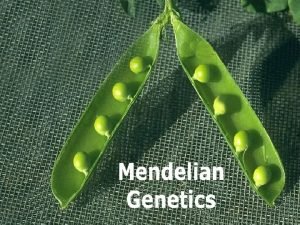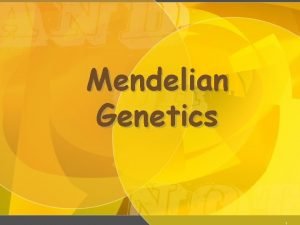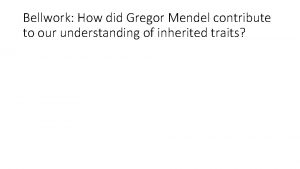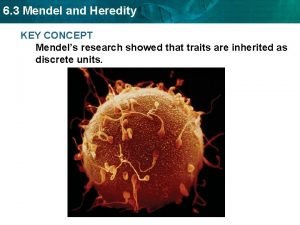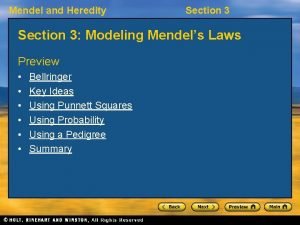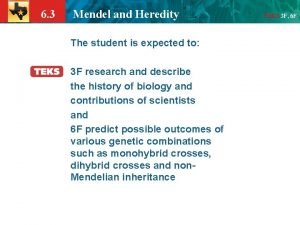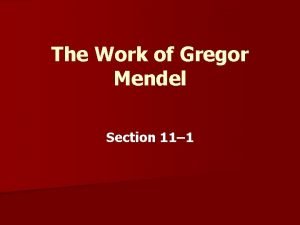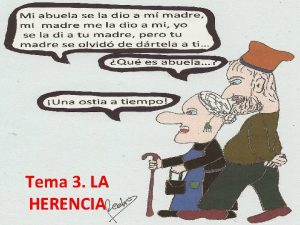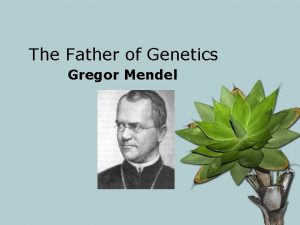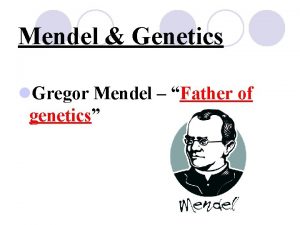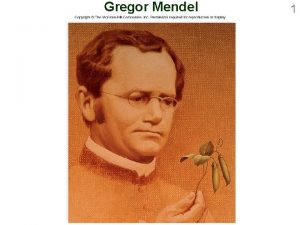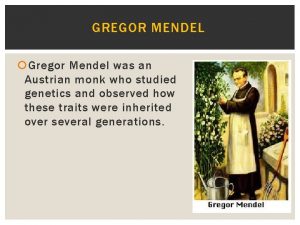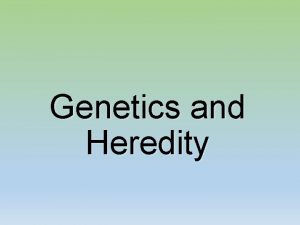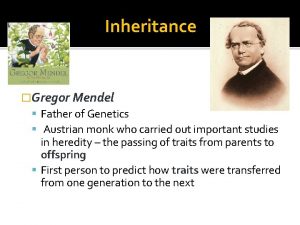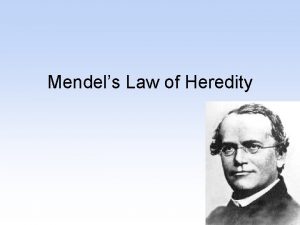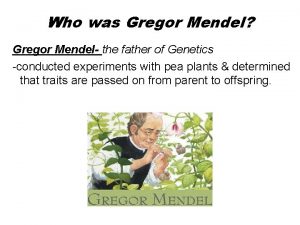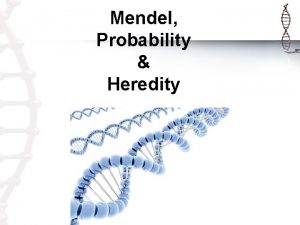Mendel Heredity Gregor Mendel Father of Genetics Austrian















- Slides: 15

Mendel & Heredity

Gregor Mendel “Father of Genetics” – Austrian monk who completed breeding experiments with the garden pea plant, Pisum sativum – Wanted to learn more about how traits were passed from one generation to the next • Terms to know: • Character ~ physical features inherited (Ex: color) • Trait ~ several possible forms of character (Ex: purple, white) • Hybrid ~ results from crossing different traits (Ex: purple with a white) • Generation ~ a group of offspring from a given group of parents (P= parental, F= filial)

More Terms to Know • Allele: one of the alternative forms of a gene that governs a characteristic • Homozygous: Having identical alleles for a trait • Heterozygous: Having different alleles for a trait

And Even More Terms • Genotype: Combination of genes for one or more specific traits • Phenotype: organism’s appearance or other detectable characteristic that results from the organism’s genotype and environment

Mendel’s results

Mendel’s Theory • Why did that happen? Purple one generation, purple and white for another generation • ALLELES – Diff. versions of traits (Ex: White trait represented by “p” allele & Purple trait represented by “P” allele) – Get one from each parent – Dominant ~ always fully expressed (P) – Recessive ~ only expressed when there is no dominant (p)

Mendel’s Laws • Law of segregation ~ each pair of alleles is separated (meiosis) & each gamete has equal chance receiving either allele (GENETIC VARIATION) • Combination of alleles for a character = genotype (Ex: PP or Pp or pp) • Combination of alleles for a trait = phenotype “physical” (Ex: PP or Pp = purple, pp = white) • Two of same alleles = homozygous (Ex: PP or pp) • Two diff alleles = heterozygous (Ex: Pp)

Mendel’s Laws con’t • Law of Independent Assortment – The allele of each gene segregate independently – One trait won’t affect another – If traits are not located close to 1 another on chromosome

Good ol’ Mendel • Why are Mendel’s Laws and work so important? Punnett squares ~ Predict the likely ratio of the genotype of a given cross – Monohybrid homozygous ~ always result in 0: 4: 0 genotype & 4: 0 phenotype offspring (Yy dominant trait expressed) – Monohybrid heterozygous ~ will result in 1: 2: 1 genotype (1=YY, 2=Yy, 1=yy) & 3: 1 phenotype (3 dominant trait expressed, 1 recessive trait expressed)

Punnett Practice • A plant has two alleles of a gene for stem length, long (L) and short (l). Two plants that are both heterozygous for the gene are crossed. Use a Punnett square to estimate the chances of getting heterozygous offspring.

Punnett Practice • A plant has two alleles of a gene for stem length, long (L) and short (l). Two plants that are both heterozygous for the gene are crossed. Use a Punnett square to estimate the chances of getting heterozygous offspring.

Punnett Practice • A plant has two alleles of a gene for stem length, long (L) and short (l). Two plants that are both heterozygous for the gene are crossed. Use a Punnett square to estimate the chances of getting heterozygous offspring.

Punnett Practice • A plant has two alleles of a gene for stem length, long (L) and short (l). Two plants that are both heterozygous for the gene are crossed. Use a Punnett square to estimate the chances of getting heterozygous offspring. Parents are “Ll” 1 LL : 2 Ll : 1 ll 2/4 are Ll (heterozygous) L l L LL Ll ll 50% chance

Punnett Practice • A cat is heterozygous for long hair (Hh), and its mate is homozygous recessive, giving it short hair (hh). If they mated and had a litter of eight kittens, how many short hair kittens would you expect to find?

Punnett Practice • A cat is heterozygous for long hair (Hh), and its mate is homozygous recessive, giving it short hair (hh). If they mated and had a litter of eight kittens, how many short hair kittens would you expect to find? Looking for “hh” 2 Hh : 2 hh 2/4 are hh (homozygous recessive) ½*8=4 H h h Hh hh
 Father of genetics
Father of genetics Austrian monk gregor mendel
Austrian monk gregor mendel Gregor mendel austrian monk
Gregor mendel austrian monk Austrian monk
Austrian monk Chapter 11 biology test
Chapter 11 biology test How did gregor mendel contribute to genetics
How did gregor mendel contribute to genetics Chapter 17 the beginning of the life cycle
Chapter 17 the beginning of the life cycle Genetics is the study of heredity and variation
Genetics is the study of heredity and variation Section 3 mendel and heredity
Section 3 mendel and heredity Section 3 mendel and heredity
Section 3 mendel and heredity Section 3 mendel and heredity
Section 3 mendel and heredity Section 3 mendel and heredity
Section 3 mendel and heredity Section 3 mendel and heredity
Section 3 mendel and heredity Gregor mendels principles of genetics apply to
Gregor mendels principles of genetics apply to Section 11-1 the work of gregor mendel
Section 11-1 the work of gregor mendel Gregor mendel guisantes
Gregor mendel guisantes

